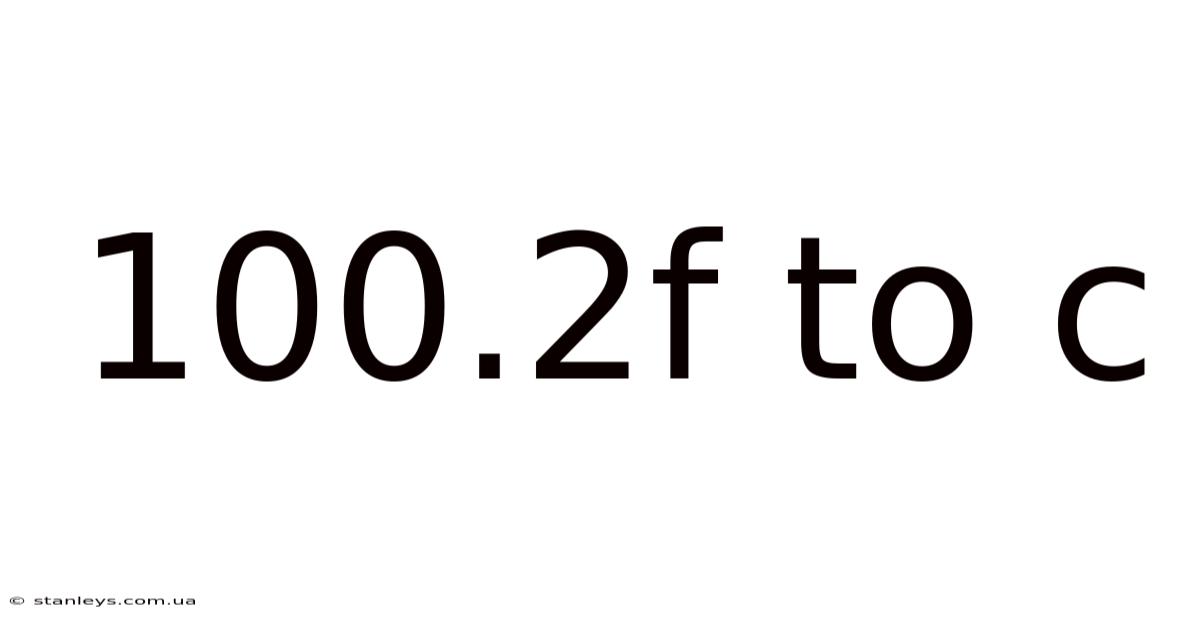100.2f To C
stanleys
Sep 17, 2025 · 4 min read

Table of Contents
Converting 100.2°F to Celsius: A Comprehensive Guide
Are you struggling to convert Fahrenheit to Celsius? Understanding temperature conversions is crucial in many fields, from cooking and everyday life to scientific research and engineering. This comprehensive guide will walk you through the process of converting 100.2°F to Celsius, explaining the formula, providing step-by-step instructions, and exploring the underlying scientific principles. We'll also address frequently asked questions and provide examples to solidify your understanding.
Understanding Fahrenheit and Celsius
Before diving into the conversion, let's briefly review the two temperature scales:
-
Fahrenheit (°F): This scale, developed by Daniel Gabriel Fahrenheit in the early 18th century, uses the freezing point of water at 32°F and the boiling point at 212°F at standard atmospheric pressure.
-
Celsius (°C): Also known as the centigrade scale, Celsius uses the freezing point of water at 0°C and the boiling point at 100°C at standard atmospheric pressure. It's the most widely used temperature scale globally.
The Conversion Formula
The conversion from Fahrenheit (°F) to Celsius (°C) is governed by a simple linear equation:
°C = (°F - 32) × 5/9
This formula effectively scales and shifts the Fahrenheit scale to align with the Celsius scale. Subtracting 32 accounts for the difference in the freezing point of water, while multiplying by 5/9 adjusts for the different size of the degree intervals between the two scales.
Step-by-Step Conversion of 100.2°F to °C
Let's apply the formula to convert 100.2°F to Celsius:
-
Substitute the value: Replace °F in the formula with 100.2:
°C = (100.2 - 32) × 5/9
-
Perform the subtraction: Subtract 32 from 100.2:
°C = 68.2 × 5/9
-
Perform the multiplication: Multiply 68.2 by 5:
°C = 341/9
-
Perform the division: Divide 341 by 9:
°C ≈ 37.89°C
Therefore, 100.2°F is approximately equal to 37.89°C.
A Deeper Dive into the Scientific Principles
The conversion formula is derived from the relationship between the freezing and boiling points of water on both scales. The key is understanding that the interval between the freezing and boiling points is different for Fahrenheit and Celsius.
-
Fahrenheit: The difference between the boiling and freezing points is 212°F - 32°F = 180°F.
-
Celsius: The difference between the boiling and freezing points is 100°C - 0°C = 100°C.
The ratio of these differences is 100/180 = 5/9. This ratio is the factor used in the conversion formula to scale the Fahrenheit temperature to the Celsius scale. The subtraction of 32 adjusts for the different starting point (freezing point) of the two scales.
Practical Applications and Examples
Understanding Fahrenheit to Celsius conversion is essential in various contexts:
-
Cooking: Many recipes use either Fahrenheit or Celsius. Being able to convert ensures accurate cooking temperatures.
-
Weather: Weather reports often provide temperatures in both scales. Conversion helps you understand the temperature better, regardless of the units used.
-
Medicine: Body temperature is often measured in both Fahrenheit and Celsius. Accurate conversion is crucial for diagnosis and treatment.
-
Science and Engineering: Many scientific experiments and engineering applications require precise temperature control and accurate conversions.
Example 1: A scientist is working with a solution that requires a temperature of 98.6°F. Converting this to Celsius:
°C = (98.6 - 32) × 5/9 = 37°C. This is the average human body temperature.
Example 2: A recipe calls for an oven temperature of 350°F. Converting this to Celsius:
°C = (350 - 32) × 5/9 ≈ 177°C.
Frequently Asked Questions (FAQ)
-
Q: Can I convert Celsius to Fahrenheit using a similar formula?
A: Yes, the reverse conversion formula is: °F = (°C × 9/5) + 32
-
Q: What is the significance of the 5/9 factor in the conversion formula?
A: The 5/9 factor represents the ratio of the size of a degree Celsius to a degree Fahrenheit. There are 100 degrees Celsius between the freezing and boiling points of water, and 180 degrees Fahrenheit. 100/180 simplifies to 5/9.
-
Q: What if I need to convert a negative Fahrenheit temperature to Celsius?
A: The formula works equally well for negative temperatures. Just remember to follow the order of operations (subtraction before multiplication).
-
Q: Are there online converters available?
A: Yes, many online calculators can perform this conversion instantly. However, understanding the underlying formula is beneficial for problem-solving and a deeper understanding of temperature scales.
-
Q: What is the absolute zero point in Celsius and Fahrenheit?
A: Absolute zero, the theoretical lowest possible temperature, is -273.15°C and -459.67°F.
Conclusion
Converting 100.2°F to Celsius, or any Fahrenheit temperature to Celsius, is straightforward using the formula °C = (°F - 32) × 5/9. This guide has provided a detailed explanation of the formula, step-by-step instructions, and explored the underlying scientific principles. Understanding temperature conversions is not just about calculations; it's about grasping the fundamental relationship between different measurement systems and applying this knowledge to various aspects of daily life and scientific endeavors. Remember to practice and use different examples to fully grasp the concept and solidify your understanding of temperature conversions. With practice, you’ll become comfortable and confident in converting between Fahrenheit and Celsius.
Latest Posts
Latest Posts
-
55 40 Off
Sep 17, 2025
-
30 Of 9
Sep 17, 2025
-
75 Of 160
Sep 17, 2025
-
100 Divided 15
Sep 17, 2025
-
C Est Magnifique Translation
Sep 17, 2025
Related Post
Thank you for visiting our website which covers about 100.2f To C . We hope the information provided has been useful to you. Feel free to contact us if you have any questions or need further assistance. See you next time and don't miss to bookmark.